
DATAMATH CALCULATOR MUSEUM
 |
DATAMATH CALCULATOR MUSEUM |
Texas Instruments TI-95 PROCALC
| Date of introduction: | 1986 | Display technology: | LCD dot matrix |
| New price: | $200.00 (SRP 1988) | Display size: | 16 (10 + 2) |
| Size: | 3.8" x 8.0" x
1.0" 96 x 204 x 25 mm3 |
||
| Weight: | 10.3 ounces, 290 grams | Serial No: | 0003685 |
| Batteries: | 4*AAA | Date of manufacture: | mth 05 year 1987 |
| AC-Adapter: | Origin of manufacture: | Taiwan (I) | |
| Precision: | 13 | Integrated circuits: | CPU:
TMC70011 ROM: HN61256 RAM: HM6264 DISPLAY: HD44780, HD44100 |
| Memories: | 900-0 | ||
| Program steps: | 0-7200 | Courtesy of: | Joerg Woerner |
| Download manuals: | |
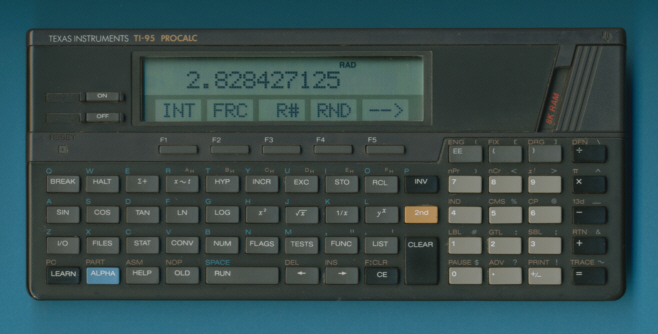
![]()
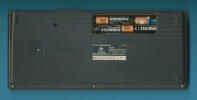 May
we call this huge portable computer a calculator? No doubt, the TI-95 Procalc
introduced in 1986 is a powerful, keystroke programmable calculator.
Some ideas of the early TI-58 calculator and
the never introduced TI-88 influenced the TI-95 PROCALC:
May
we call this huge portable computer a calculator? No doubt, the TI-95 Procalc
introduced in 1986 is a powerful, keystroke programmable calculator.
Some ideas of the early TI-58 calculator and
the never introduced TI-88 influenced the TI-95 PROCALC:

 You’ll find an expansion port to install either
RAM or ROM-cartridges and you may connect a printer PC-324
through the Dock-Bus
to the calculator.
You’ll find an expansion port to install either
RAM or ROM-cartridges and you may connect a printer PC-324
through the Dock-Bus
to the calculator.
Already without any expansion the TI-95 features up to 8k Bytes of memory, the expansion adds another 8k Bytes. The display uses a 5*7 dot matrix instead the
normal 7-segment design to give full alphanumerical capability. A close relative
to the TI-95 PROCALC, the TI-74
BASICALC explains the
typewriter style keyboard.
| Part | New price | Description |
| PC-324 | $115.00 (SRP 1988) | 24-column thermal printer |
| PA-201 | (SRP 1988) | Power adapter adaptor for TI-74, TI-95 |
| AC9201 | $19.00 (SRP 1988) | Mains adapter for PC-324 |
| TP-324 | $6.00 (SRP 1988) | Thermal paper for PC-324 |
| CI-7 | $35.00 (SRP 1988) | Cassette Interface |
| CM-8 | $50.00 (SRP 1988) | 8k Constant Memory Module (RAM) |
| Mathematics | $50.00 (SRP 1988) | Library (ROM) |
| Statistics | $50.00 (SRP 1988) | Library (ROM) |
| Chemical Engineering | $50.00 (SRP 1988) | Library (ROM) |
| TI-892F | $114.95 (SRP 1988) | 32k programmed EPROM Module (First) |
| TI-892D | $84.95 (SRP 1988) | 32k programmed EPROM Module (Dupl.) |
| TI-892E | $76.95 (SRP 1988) | 32k programmed EPROM Module (Bulk) |
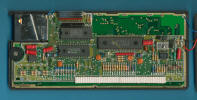 In
1987 Texas Instruments introduced Programmable
Calculator News, a service for TI-74 and TI-95 users to feature program
listings, technical articles, question and answer segments, new product reviews, and user comments. All
Programmable Calculator News are
available for free download as a service provided by the Datamath Calculator
Museum.
In
1987 Texas Instruments introduced Programmable
Calculator News, a service for TI-74 and TI-95 users to feature program
listings, technical articles, question and answer segments, new product reviews, and user comments. All
Programmable Calculator News are
available for free download as a service provided by the Datamath Calculator
Museum.
Dismantling
the featured TI-95 PROCALC manufactured in May 1987 by
Inventec Corporation in Taiwan, reveals a rather complex
design with two printed circuit boards (PCB's).
The
HN61256
ROM
of this TI-95 PROCALC was manufactured by Hitachi and offers a capacity of 32k
Bytes with a rather slow access time of up to 3.5 us. With the TMC70C40 CPU
lacking a "wait-state" mechanism, incorporates the TMC70C46 additional circuitry
to slow down the CPU clock cycle while accessing the ROM chips.
RAM
(Random Access Memory): The RAM is used as data memory and is used to store both
variables, user programs and intermediate results. This TI-95 PROCALC makes use of
HM6264 manufactured by Hitachi, Japan
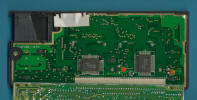 The
second (lower) PCB of the TI-95 PROCALC contains not only the contacts for the keyboard but the complete
display assembly:
The
second (lower) PCB of the TI-95 PROCALC contains not only the contacts for the keyboard but the complete
display assembly: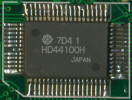
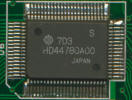 DISPLAY:
The display electronics of the TI-95 PROCALC uses a combination of the Hitachi
HD44780 dot-matrix LCD controller with 40 segment and 16 common drivers and one
Hitachi HD44100 driver supporting 40 additional segments.
DISPLAY:
The display electronics of the TI-95 PROCALC uses a combination of the Hitachi
HD44780 dot-matrix LCD controller with 40 segment and 16 common drivers and one
Hitachi HD44100 driver supporting 40 additional segments.
It took only 4 years till Texas Instruments introduced with the TI-81 their first Graphing calculator and another 5 years to the unbelievable TI-92.
If you don't own a TI-95 calculator - emulate it!
If you have additions to the above article please email: joerg@datamath.org.
© Joerg Woerner, December 5, 2001. No reprints without written permission.